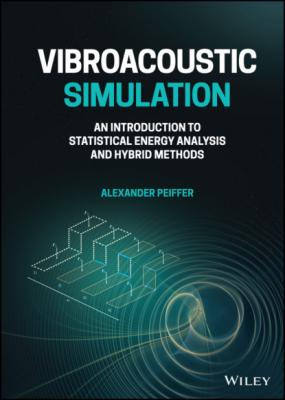Vibroacoustic Simulation. Alexander Peiffer
Чтение книги онлайн.
Читать онлайн книгу Vibroacoustic Simulation - Alexander Peiffer страница 13
 alt="StartLayout 1st Row 1st Column u left-parenthesis t right-parenthesis 2nd Column equals bold-italic u e Superscript j omega t Baseline 3rd Column v Subscript x Baseline left-parenthesis t right-parenthesis 4th Column equals j omega bold-italic u e Superscript j omega t Baseline equals bold-italic v Subscript x Baseline e Superscript j omega t EndLayout"/> (1.26)
alt="StartLayout 1st Row 1st Column u left-parenthesis t right-parenthesis 2nd Column equals bold-italic u e Superscript j omega t Baseline 3rd Column v Subscript x Baseline left-parenthesis t right-parenthesis 4th Column equals j omega bold-italic u e Superscript j omega t Baseline equals bold-italic v Subscript x Baseline e Superscript j omega t EndLayout"/> (1.26)
with u and vx as complex amplitudes of the displacement and velocity, respectively. Introducing this into Equation (1.23).
and solving this for u gives:
The magnitude u^ and the phase ϕ of u are:
At ω = 0 the static displacement amplitude is u^0=F^x/ks. Using the definitions from (1.6) and dividing u^ by u^0 gives the normalized amplitude
and phase
It can be shown that the maximum of u^ is at
and the maximum value is
with the corresponding phase
The evolution of u^/u^0 and ϕ0 is shown in Figures 1.6 and 1.7 for different ζ. One can see the resonance amplification at ωr that would be infinite in case of ζ = 0 and the decrease of the amplitude with increasing damping. For ζ>1/2 the maximum value occurs at ω = 0, so the displacement is just a forced movement without any resonance effect.
Figure 1.6 Normalized amplitude of forced harmonic oscillator. Source: Alexander Peiffer.
Figure 1.7 Phase of forced harmonic oscillator. Source: Alexander Peiffer.
The frequency of highest amplitude is called the amplitude resonance and it is different from the so called phase resonance with ϕ=−π2, which corresponds to the resonance of the undamped oscillator.
1.2.2 Energy, Power and Impedance
It is helpful to investigate the ongoing processes from the energy perspective. For an undamped system cv=0 that oscillates with u(t)=u^cos(ω0t) and absence of external forces the energy remains constant. The energy is the sum of kinetic Ekin and potential energy Epot
and is constant, but spring and mass exchange energy twice over one period T0.
Figure 1.8 Kinetic and potential energy of the harmonic oscillator. Source: Alexander Peiffer.
As energy quantities are not always constant, this motivates the definition of time average values. average ! time We introduce the mean-square (ms) and root-mean-square (rms) value for the time average for an arbitrary signal x(t). The mean-square value over a time T is
In